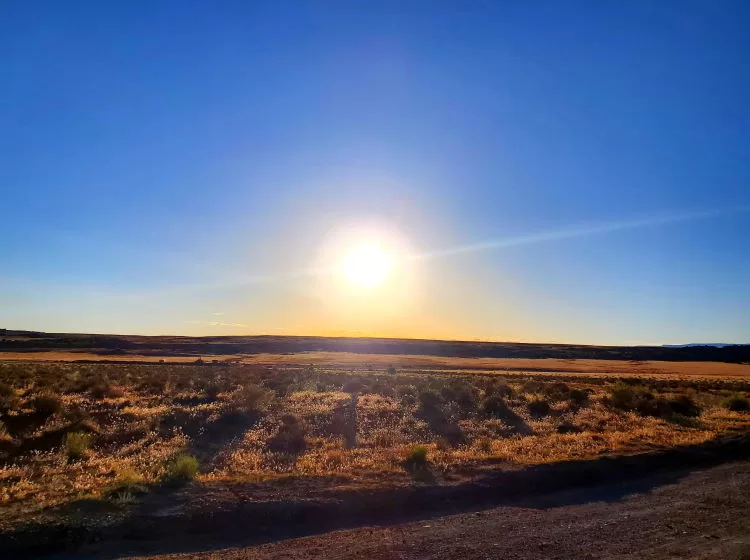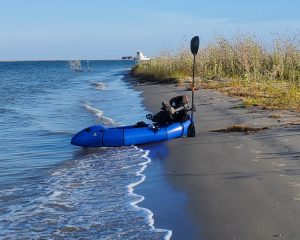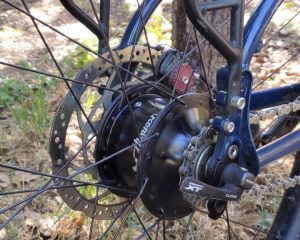It’s that time of year and the heat has returned. Some of the most frequent questions I’ve gotten from other cyclists have been about cycling in the heat. While warm weather is often welcomed, cycling in the hottest weather can present significant challenges. Cycling in the heat creates greater stress on your body and impairs your performance. In extreme cases, it can cause permanent injury or death.
A lot has been written on this subject, but those works often fall into being overly technical/specialized or being too general and sometimes scientifically unsound. This article is written from my own perspective as an avid rider and a scientist. I will touch on points that directly impact performance, comfort, and safety. Not everything I discuss in detail will be useful for every rider as those who are race/event training, fitness, commuting, touring/bikepacking, or casual riding will all have different needs, but I think the overall themes are broadly applicable. I’ve organized this discussion into a brief introductory background and the seven strategies below.
Introduction
Tips and Strategies for Hot Weather Cycling
- Avoid Riding in the Hottest Part of the Day
- Begin Hydrated, Stay Hydrated, Continue Hydrating After
- Choose Routes to Minimize the Effects of Heat
- Dress Appropriately and Use Sunscreen
- Pacing and Heat Acclimation
- Adequate Rest and Recovery
- Know When to Stop
Introduction
Why Does Your Body Need to Cool Itself?
Your body can only function properly when its core temperature is within a narrow range. As your core temperature rises above the normal range (hyperthermia), performance may decrease and the chance of heat related illness increases. Outside factors like the temperature of the air and sun exposure may contribute to this, but the largest source of heat while cycling will come from within your own body. While we like to think of cycling as energy efficient, only ~20-25% of our expenditure will end up as mechanical energy to propel the bike. The majority of the energy ends up as wasted metabolic heat. Cyclists often talk about performance in terms of the amount of power (in watts) that they can produce to propel the bike. Most of the metabolic energy a cyclist generates never makes it to the pedals as mechanical energy and instead becomes thermal energy (~70-75%). For example, an elite cyclist weighing 70 kg and producing 6 W/kg (420 watts) will be producing ~1,400 watts of heat energy.
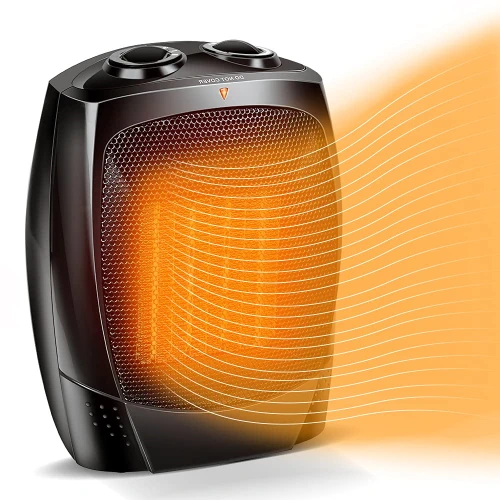
Even at a more reasonable 200 watt output a cyclist will be producing around 700 watts of waste heat. To maintain the body’s temperature within the required range, thermal energy must be dissipated.
How Does Your Body Cool Itself?
The Physical Principals
To understand how the body cools itself, we must understand how heat energy is transferred. There are 4 common ways that your body can cool itself: radiation, conduction, convection, and evaporation. When cycling in hot weather, all of these may be happening at some level, but evaporation and convection typically contribute the vast majority of the cooling power depending on conditions.
Every object you encounter emits thermal radiation and higher temperature objects emit a lot more thermal radiation (rate of thermal radiation is proportional to the 4th power of it’s temperature). If you were simply standing in a cool indoor room, radiation would be the primary method that your body dissipates heat.
Conduction is the direct transfer of heat between two objects that are in contact. Whenever you’ve picked up a hot object or a piece of ice with your hand then you’ve directly experienced conduction. While conduction may occur between anything your body is directly in contact with (e.g. clothing, handlebars), it is not the major player in cooling while cycling.
Convection is the transfer of heat by the movement of a fluid (liquid or gas). If you are riding a bicycle outside on a cool day and not sweating, it’s likely that much of that heat is being removed by convection as the air moves around you as you are propelled forward. This can also be felt when riding on a stationary trainer with and without a fan. At the same effort you will find that you start sweating sooner without the forced convection of the fan. That sweating brings us to the final heat transfer and the one that’s going to be the most important out in the heat.
Evaporative cooling is a form of latent heat transfer in which a liquid becomes a gas (phase change). It turns out that this phase change requires a lot more energy than simply raising the temperature of the liquid. So when a liquid (like sweat) evaporates it removes a relatively high amount of energy. In sustained high output cycling activity in a warm environment, sweat evaporation will become the largest source of cooling. As air temperatures increase above skin temperature, the dry heat exchange (i.e. convection, radiation) will eventually begin to add heat to your body instead of removing it as seen in the chart below.
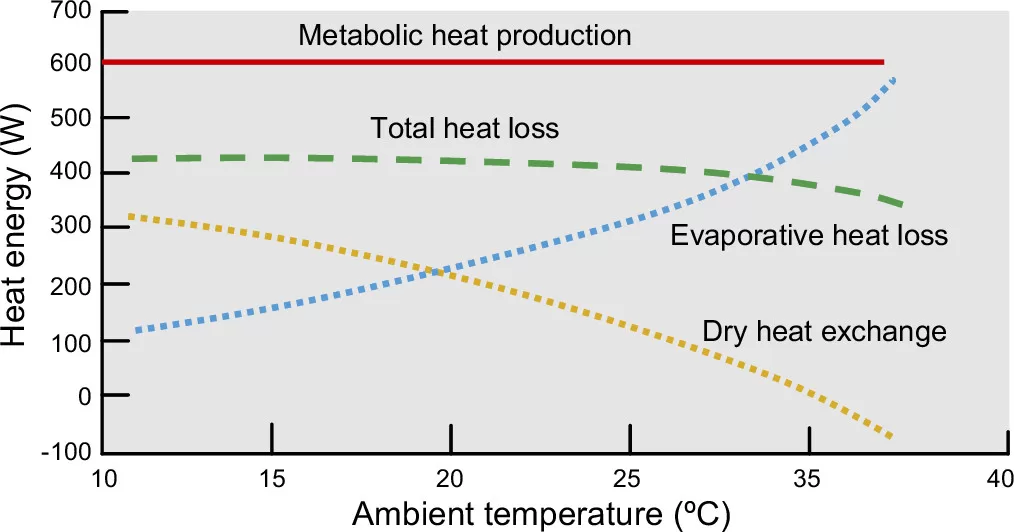
Figure and caption from: Periard et al. Physiological Reviews. 2021.
The Body’s Physiological Responses
As I just mentioned, one way your body responds to elevated temperature is by producing sweat. As the heat burden becomes greater on your body, it will respond by producing more sweat up to a maximum sweat rate. The more sweat that evaporates from your skin, the greater the cooling effect. Another noticeable response by your body will be an increase in heart rate. The increase in heart rate will result in higher blood flow and by this forced convection move heat in your body from where it is generated to where it can be dissipated. Another response is the dilation of blood vessels in the skin. This allows more blood (carrying heat away from your muscles and core) to travel through your skin. Your skin is the primary place from which excess heat can be transferred out of your body during intense activities in a warm environment by the effects of evaporating sweat.
Defining Hot Weather
Elevated air temperature may be the first thing that comes to mind, but it is not the only factor to consider when talking about hot weather. High humidity contributes significantly to heat effects by inhibiting the evaporation of sweat. This makes “heat index” a useful value to look at as it uses both temperature and the relative humidity to give a better idea of the perceived effects. Another measurement called “wet bulb temperature” (WBT) using a special wet bulb thermometer also provides a way of integrating the effects of both temperature and humidity. But all three of these methods assume measurements in the shade. How can we get a better estimate?
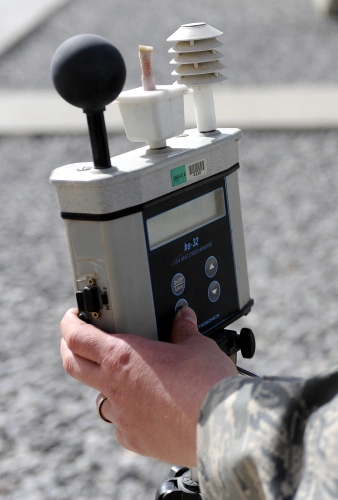
Riding in exposed areas will also subject you to direct solar radiation which raises the temperature of your clothing and exposed skin. To get an even better estimate of the heat effects we can use the similarly named “wet bulb globe temperature” (WBGT). The WBGT uses values from three different types of thermometers: a standard dry bulb thermometer (used for typically reported temperatures), a wet bulb thermometer (used for WBT), and a third black globe thermometer (used to measure sun exposed temperature). These three values are then plugged into a formula to give a single value that more accurately predicts the combined effects of the heat. WBGT is the standard by which the military, OSHA, other government organizations, and some sporting groups use to estimate the safety of human workloads. Most weather stations do not report these values (or don’t have the equipment to), but some attempt to approximate these values algorithmically.
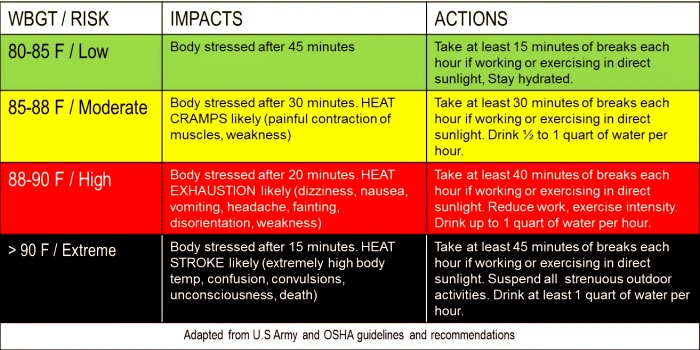
The temperatures in that chart might be lower than you expected, but the WGBT temperature value is typically lower than the standard temperatures you are accustomed to seeing. For example, as I write this currently in the afternoon, the air temperature outside is 102 F, the heat index is 103 F, and the estimated WBGT is 86 F. The WBGT was actually higher earlier in the day when the temperature was lower and the humidity was significantly higher. This would qualify as moderately dangerous heat and has dangers as illustrated in the chart above. Doing long intense activities in these conditions should be avoided. There are weather conditions where activities are definitely unsafe, and it is your responsibility to make that determination for yourself. That’s enough talk about the heat, so let’s get to some strategies that I use to get the most out of hot weather cycling.
Tips and Strategies for Hot Weather Cycling
1. Avoid Riding in the Hottest Parts of the Day
This may seem like a bait and switch, but if you can avoid riding in the heat that’s usually best. Weather forecasts are invaluable to planning rides, and hourly forecasts can help you find the best times and insure you have plenty of time so that you make it back before the heat. Here in central Texas, on most summer days the temperature reaches potentially dangerous levels in the afternoon. However, the mornings provide a good window of time for riding even on the hottest days. The temperature here usually stays elevated well into the evening but temperatures do eventually drop. Personally, I don’t like to do hard efforts late in the evening as I think it impairs my sleep and recovery and riding in the dark can present its own challenges and risks, but there are options for late evening riding. For example, I live close to the Veloway in Austin. It’s a 3 mile paved track that is free to use and stays open until 10 pm. A facility like this can be great for night time riding as it is both pedestrian and car free. Single track trails may be another option for late evening rides. Finally, for those looking for fitness benefits, indoor trainer sessions can be a suitable option when weather and schedules do not present great opportunities for riding outside.
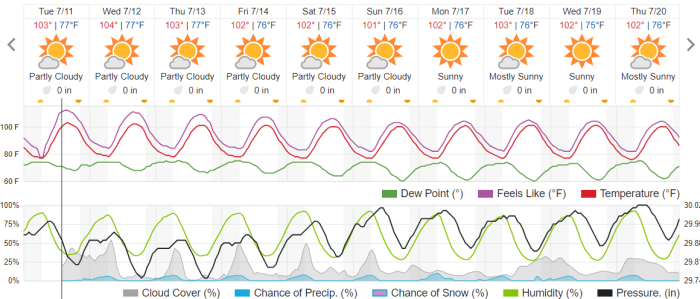
2. Begin Hydrated, Stay Hydrated, Continue Hydrating After
Increased heat leads to more sweating so it’s probably no surprise that hydration is important. I would go a step further and say that proper hydration is critical in the heat as it is required for both best performance and safety. The primary method your body uses to dissipate heat in hot conditions is through sweat evaporation. If you become dehydrated, your body will not produce sweat at the maximum rate. Limited sweat production can limit the rate at which sweat evaporates and your body will not be able to dissipate the heat as well. Blood plasma volume may also decrease with dehydration. This will result in decreased cooling capacity since your blood is the primary way that heat is transferred from your core to your skin.
Begin Hydrated
So much of what impacts your performance on the bike happens before you ever get on it. While hydrating during a ride usually get the most attention, it’s not uncommon to overlook the benefits of ensuring proper hydration before riding. Ok, so how can you can get an estimate of your hydration level?
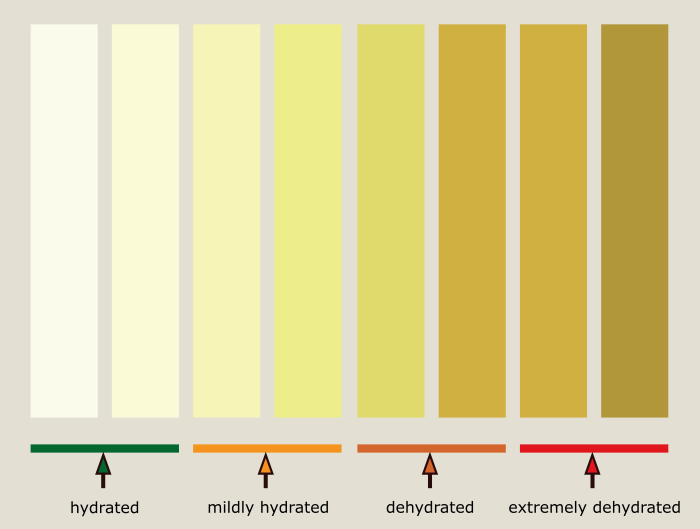
Figure Attribute: A. Rehman. CC BY-SA 4.0
A common method of accessing hydration status is by urine color which varies with concentration. As you can see in the chart above, the darker the urine, the less hydrated you are. This method has caveats, notably that certain foods and vitamins can darken the color of your urine. Conversely, consuming alcohol or other substances that have diuretic properties will initially dilute your urine making it lighter while contributing to subsequent dehydration. While regular or significant alcohol consumption is detrimental to cycling performance in general, it is especially bad in the heat because of it’s dehydrating effect. Coffee and other caffeine sources can also have a dehydrating effect and excess intake can elevate heart rate even further.
Stay Hydrated
Common advice is that cyclists and other athletes should drink to thirst during an activity. This may work for a lot of people, but, personally, I will end up dehydrated on long rides if I don’t make some mental effort to stay on top of my hydration and that’s made worse by the heat.
At what level does dehydration become performance impairing? Studies have shown that greater than ~2% loss of body mass (relative to normal hydrated body mass) is where detrimental effects may begin to occur. For me that would be when I have sweated ~1.4 liters without replacement. Maximum sweat rates are usually above 1 liter per hour, but can vary quite a bit between individuals with rates up to 2 liters per hour not uncommon (I’ll discuss this more below). Being an above average sweater myself, I would lose that in less than an hour under high intensity effort. For a two hour high intensity ride in the heat I would need to consume around 2 liters to finish without dipping below a 2% loss of body mass. There is no performance benefit to replacing every drop of fluid lost to sweat.

Water bottles come in a variety of sizes with the most common being around 600mL (~20 oz), but when it’s hot I usually carry 1 liter (~34 oz) bottles. They fit just the same in both cages on my road bike and it gives me greater capacity than even carrying three of the smaller bottles. How many bottles should you carry? For me, that depends on how long I’m riding and how far I intend to ride before I will reach a reliable refill stop. For a two hour ride without stopping for a refill, the two large bottles are sufficient. On shorter rides or if I’m planning frequent stops, a single bottle may be enough, but it’s pretty common for me to ride with two just so I have to stop less or if it’s in a more remote or rural location where refill options are limited. When riding logging and forest roads in Oregon, I usually carried a lightweight water filter and enjoyed refills from the cold mountain streams. The most water I’ve ever carried on a bike was 12 liters on sections of the Texas Coast Bikerafting Route simply because there was not access to any kind of fresh water for two days. Real problems can show up if you run out of stuff to drink mid-ride and are thirsty. The best advice I can give is always plan your hydration stops, take a bit more than you think you will need, drink regularly while riding so that you don’t consume a lot at once, and never skip refill stops.
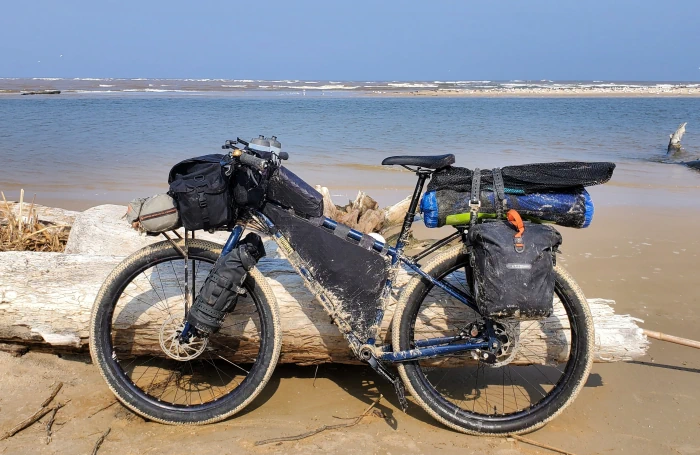
What you put in your bottles is also important and becomes more critical as ride length increases. I add ice to my bottles in hot weather as it makes the drinks more enjoyable (important because I’m going to need to drink a lot if it) and it can provide a small cooling benefit. Water is not the only important thing lost in sweat. Electrolytes are ionic substances in your body that include minerals lost in sweat (sodium, chloride, potassium, magnesium, and calcium). Sodium and chloride are the electrolytes most abundantly lost in sweat. About 1 gram of sodium per liter of sweat is average although some individuals can lose more or less. Long activities can require significant fluid replacement and sodium levels can be depleted to dangerous levels if it is not supplemented. Commercially available electrolyte mixes are available or about 2.5 grams of table or sea salt will provide 1 gram of sodium. You are unlikely to cause deleterious depletion of the other ions (potassium, magnesium, and calcium) during a single activity, but chronic training in the heat with high sweat losses could lead to deficiency over time if adequate intake is not present in your diet.

Also, if your urine is the same color as this logo then you should be drinking more fluids.
Generally, anything 2 hours or more and I’m going to want to want some kind of caloric intake. One of the few things worse than running out of energy is running out of energy and being dehydrated. Some items you might normally carry with you to eat may not hold up so well out in the heat. I typically opt for some, if not all, calories in liquid form in very hot conditions.
Over-hydrating is a rarer problem, but I will mention it for safety. It can occur if one drinks an excessive amount of water or prolonged water replacement without sufficient electrolyte replacement. This can cause a vary serious condition when sodium levels drop too low in the blood (hyponatremia). The goal is to maintain sufficient hydration, not exceed it.
Continue Hydrating After
Rehydrating after an event or long training is important to optimize recovery. After the activity is the time to make sure to top things back up to normal hydration levels. Studies have also shown that recovery drinks that include carbohydrates and protein in addition to electrolytes provide benefits and this is general advice whether in the heat or otherwise. The question may arise as to how much fluid you need to achieve hydration as this may be difficult to determine. One way you can get a good estimate is weighing yourself with a reasonably accurate digital bathroom scale before the activity and then making a measurement afterwards (eg. if you lost 1 kg of weight, then 1 liter of fluid). This same type of measuring can also be used to calculate your personal sweat rate which I’ll talk about in the next section.
Diving a Bit Deeper Into Hydration
Developing an optimal hydration strategy is complicated by the fact that individuals can vary greatly in both the amount of sweat that they produce and the concentration of sodium lost in their sweat. For most hydration purposes, the sweat rate is the more important. It turns out that sweat rate is also the easier of the two to measure. The most accurate way to measure sweat loss is by measuring your weight before and after an activity and the only piece of equipment that you need is a digital bathroom scale. This can even be done without leaving your home if you have an indoor trainer. For a detailed protocol to estimate your sweat rate, check out this article.
If you record your rides with a Garmin Edge cycling computer, you can get estimated sweat loss for the activity after saving it on the device and this can also be reviewed later in Garmin Connect. The Garmin sweat loss metric uses a number of factors including “effort during activity and other information available from your Garmin devices. These factors may include FTP, weight, distance traveled, speed, elevation gain, temperature, heart rate and other variables.” This isn’t going to be tailored to your specific sweat rate, so if you fall outside the typical range you may be able to increase accuracy somewhat by making adjustments based on what you know about your personal sweat rate. Comparing to actual measurements on a few rides will give you an indication of whether these estimated values are useful.
As activities become increasingly longer, the accuracy of hydration replacement becomes increasingly important. You could under estimate your hydration needs by a few hundred milliliters each hour for a few hours before you become dehydrated, but as more time passes you will eventually reach that point. This can become increasingly problematic with ultra-endurance type activities but they are typically not undertaken in high heat (and shouldn’t be!) so I’ll save that discussion for another day.
3. Choose Routes to Minimize the Effects of Heat
The route that you choose to ride can have a significant impact on on your heat exposure and how efficiently your body can cool itself. There are two general strategies that I use: minimizing direct sun exposure and maximizing air flow.
Minimizing Direct Sun Exposure
On a hot summer day, it is easy to appreciate the difference between sitting in the sun versus the shade. This also applies to activities including cycling. Staying out of the direct sunlight as much as possible will decrease your heat burden. While it may be easy to find a shady spot to relax, it can be a bit more challenging to plan a cycling route that incorporates significant amount of shade and will likely take some upfront planning and knowledge of that area. The results can be worth the effort as riding in the shade provides direct benefits by reducing the heat from direct solar radiation. The surfaces you ride on will be cooler so there will be less direct radiant and reflected indirect heat from below as well. Multi-use trails can be a good option because they often have increased shade coverage. This can also make single track trails a good option in many areas to avoid direct sun exposure.
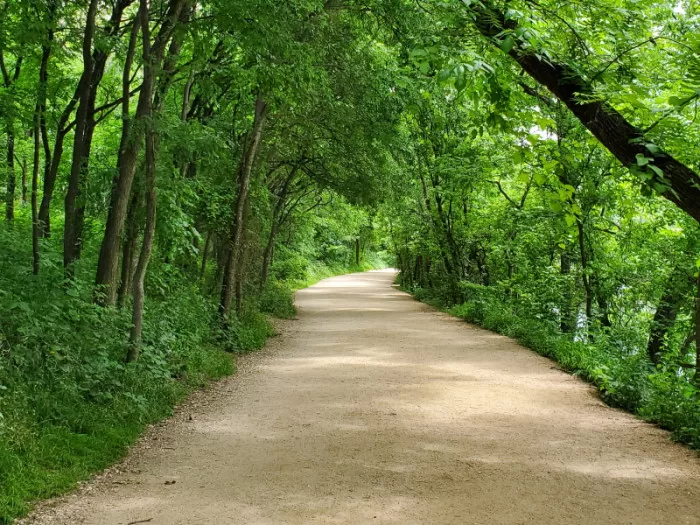
Why does this work?
On a clear summer day, solar radiation reaching the ground can be around 1,000 watts per square meter. The average surface area of an adult male is a bit under 2 square meters. Clearly, only part of your clothing and skin is directly exposed to the sun and only some radiation is absorbed, but there’s still a lot of extra thermal energy from just being in the open. Avoiding exposure to that solar energy keeps you cooler by avoiding the need to dissipate potentially a couple hundred watts of extra thermal energy. It also reduces your chance of sunburn which should always be avoided as sunburn causes damage to your skin, increases skin cancer risk, impairs your body’s ability to cool itself, and impairs your rest and recovery.
Maximizing Air Flow
Air flow is key to maximizing the two big ways that your body is cooled while cycling: evaporation of sweat and convection. In hot conditions, evaporation of sweat becomes the major cooling force, but if sweat is dripping off of you instead of evaporating then you are not getting that powerful cooling effect. Of the factors influencing evaporation rate, air movement is one that we can influence while cycling. If you’ve ridden on an indoor trainer with and without a fan you will have definitely appreciated this difference.
How can you increase air flow while cycling outside in the heat? One way is to go faster, but the problem is that increasing your speed requires increasingly more power output the faster you go. The more power you produce the more heat you generate. So simply riding faster by more effort will not result in increased net cooling. To get the benefits of increased airflow, we need to maximize air flow for the amount of effort and route choice can impact this.
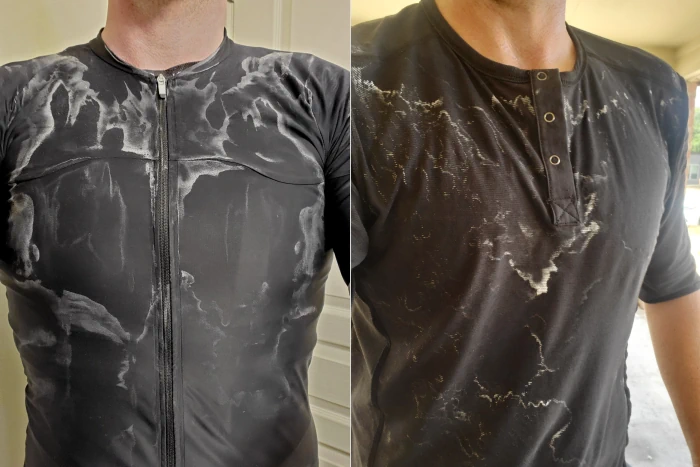
For road cycling, I choose routes to minimize in town areas, traffic lights, very curvy roads, and long grinds up steep hills. If you already have a bunch of routes that you ride in an area, it’s likely that those where you maintain the highest average speed are good candidates. Riding offroad surfaces will almost always require more energy output to maintain the same speeds. The lost cooling effect may be partially or completely offset because trails in many locations are more heavily shaded. There comes a point though where terrain can be overly technical to the point that you are exerting a lot more energy to maintain speed and you may find yourself dripping sweat because there is insufficient airflow to promote evaporation. In those kinds of conditions, smooth flowy trails allow you to maintain more cooling airflow for the same energy expenditure.
Why does this work?
It’s hard to overstate just how important sweat evaporation is to keeping you cool in the heat. Lets say you sustain 200 watts for an hour and produce 700 watt hours of excess heat. How much sweat evaporation would be needed to dissipate that heat? The latent heat associated with the evaporation of 1 mL of sweat is ~0.686 watt hours, so just over 1 liter of sweat evaporation. This is a theoretical max cooling and significant losses occur, so it would definitely require more than this, but it illustrates the magnitude of sweat evaporation as a cooling mechanism. If you’re dripping sweat, you are not getting the full benefit.
The Luxury of Microclimates
If you live in a location that has nearby microclimates, then selecting a cooler location may be another option. This worked well when I was in the Portland area of Oregon. With mountains on both sides of the Willamette Valley and the cold Pacific Ocean not far away, I usually didn’t need to travel far to find cooler places to ride. Unfortunately, this doesn’t work well for me here in central Texas currently. Staying outside of the city center here can have a modest result in a few degrees cooler by avoiding the urban heat island effect.
4. Dress Appropriately and Use Sunscreen
The clothing that you wear in hot weather can greatly impact your body’s ability to cool itself. Hot weather clothing needs to have as little insulating effect as possible and maximize sweat evaporation while still providing sufficient protection from UV radiation. It would also be beneficial to reflect as much external radiation as possible while allowing infrared radiation from your body to escape. The color of a piece of clothing is often thought to play a role in the heat absorption because white surfaces reflect more of the sun’s radiation in the visible spectrum, but dark colored material can also be made to reflect solar irradiance (e.g. coldblack). I personally do not switch to white kit in the heat, but typically wearing lights colors could have a small advantage in direct sun.
For road and gravel riding, race kit (jersey and bib shorts) usually works just fine as it’s designed to keep you cool during hard efforts. You could run into issues with cycling clothing designed for everyday, casual, endurance, or more leisurely riding, as the materials are often heavier and not as well ventilated.
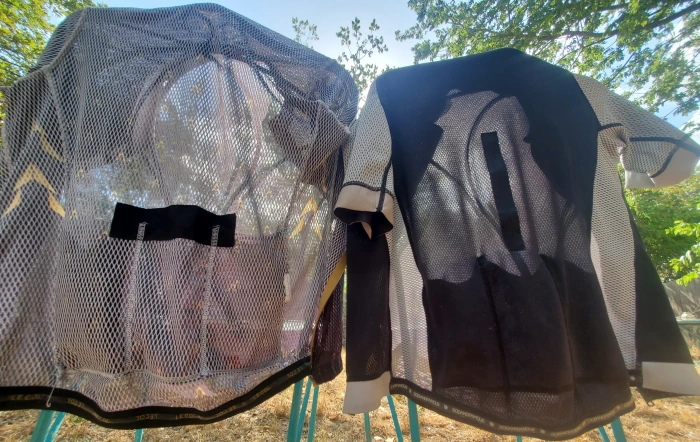
If you are planning to ride in the heat often, there are jerseys designed specifically for hot weather available from many cycling clothing companies. These jerseys are made of much lighter material (typically <100 g/m2 or gsm) and have increased ventilation. This can increase cooling but it should be pointed out that there are sacrifices. The lighter, thinner materials are a lot less durable (never put one in a washing machine or a dryer, hand wash and hang dry only!). The thinnest of these materials may not provide sufficient UV protection for your skin and necessitate the use of sunscreen underneath. The partial see-thru aesthetic will also not appeal to everyone. This past week in Texas, I decided to do a comparison between one of my regular race style jerseys and one of my ultralight hot weather jerseys. I did two rides of the same route at a similar pace on two different days with nearly identical conditions other than the jerseys. I felt noticeably cooler with the hot weather jersey during the ride, and I felt less fatigued and less hot at the end of the ride. If you live some place that is really hot a lot of the year and are OK with the sacrifices mentioned above, I think they can be worthwhile.
I think a base layer under a jersey in hot weather is a bad idea for multiple reasons. First, adding an additional layer of fabric has an insulating effect. Second, it creates a situation where more evaporation of sweat happens further from your skin (less cooling effect). An exception is that when I ride my mountain bike in hot weather sometimes I just wear a breathable base layer with nothing over it (no jersey) and a pair of mountain bike shorts designed for hot weather. Mountain bike shorts designed specifically for hot weather may be made of lighter weight materials, and have mesh panels or other ventilation strategies.
Helmets are an item where the ventilation can have a significant effect on coolness. A well ventilated helmet will allow more convective air flow through the helmet and increase the rate of sweat evaporation from your head. For road users this could be an issue with some aerodynamically optimized designs that have reduced ventilation. Personally, I just use the same helmets (both road and mtb helmets) year round which provide adequate ventilation in the summer and I wear a cap underneath in the cooler months if needed. The color of the helmet is unlikely to have a significant effect since there is so much insulating foam between the outer shell and your head. I clean the helmet after each ride and replace the padding inside as needed to ensure it absorbs and redirects sweat away from my eyes (on my current road helmet I get about a year of use before the padding needs to be replaced). For some helmet designs it may be beneficial to wear a sweatband underneath to help direct sweat from the eyes.
Foot wear is the last piece of clothing I’ll discuss. For road cyclists, typical shoes designed for racing are already designed to be well ventilated (a more common problem is that road shoes do not provide enough warmth in the winter). Mountain bike shoes can be more variable, and I would recommend against any that are not designed for summer riding or have waterproof membranes as they will not allow water vapor to leave as freely and will end up with soggy feet in the heat. For touring and casual riding on non-technical terrain in the heat, I often use flat pedals and wear sandals (with sunscreen if needed).
In hot weather I prefer to carry as little as possible in my jersey pockets and do not carry hydration on my body (no CamelBaks, hydration vests, etc). I prefer to maximize sweat evaporation and if I need to carry extra stuff I use a bag attached to the bike or bottle/cargo cage.
Sunscreen
Hot weather is often accompanied by an increased UV index and sunscreen should not be overlooked. Sunscreen prevents sunburn which causes damage to your skin, increases skin cancer risk, and impairs your body’s ability to cool itself. Sunscreen ingredients typically work by either absorbing UV rays or reflecting them which also reduces thermal burden on your skin potentially. The highest UV part of the day typically happens well before the hottest part of the day. So even though you may be riding before the afternoon heat you can still be subject to intense UV. The best sunscreen is the one that you will regularly use. Basic properties that are important are an SPF of at least 30, water resistance so that it doesn’t immediately sweat away, and that it is easy to apply. On long activities, make sure to reapply as often as indicated (a higher SPF does not allow you to reapply less often!).
In rare circumstances, I use sun sleeves in the most brutal high UV exposure environments. On the Texas Coast Bikerafting Route, I found that sunscreen alone is not enough to protect from longs days of riding on the beach by the ocean. Both the water and sand can reflect more of the sun’s radiation increasing your exposure. Long sleeves may seem counterintuitive, but in this case the sun protection actually provides enough benefit. This isn’t re-purposing arm warmers though, they should be designed for hot weather.
5. Pacing and Heat Acclimation
Pacing is important in any activity performed at high intensity or for an extended time. Simply put, if you ride too hard at the beginning of a ride, you will find that you do not have enough energy to sustain the later part. Now lets look at the heat problem in a simplified way. There is a rate at which heat is produced by your muscles (plus radiation from the environment) and a rate at which heat is removed from your body (e.g. sweat evaporation, convection, radiation). If the rate of removal is less than the rate of production, then body temperature will rise to an elevated temperature (hyperthermia). If hyperthermia increases too much, your performance will be impaired and heat related illness can occur. Let me be clear, heat related illness is a big problem. It’s the third most common way athletes die during activities (after cardiac arrest and head trauma).
But lots of people still ride in the heat, and high intensity efforts can produce an amount of heat that can easily exceed your body’s ability to cool itself. So why are people not constantly overheating on their bikes? One reason is that heat stress increases your perceived exertion and you may lower your pace in response, thereby reducing your rate of heat production. Another reason is that the initial symptoms of heat related illness may provide enough warning before conditions become life threatening. While there are likely many other reasons, I’d like to focus on an important performance related one. Heat stress significantly inhibits your maximum power output and thereby your ability to produce heat.
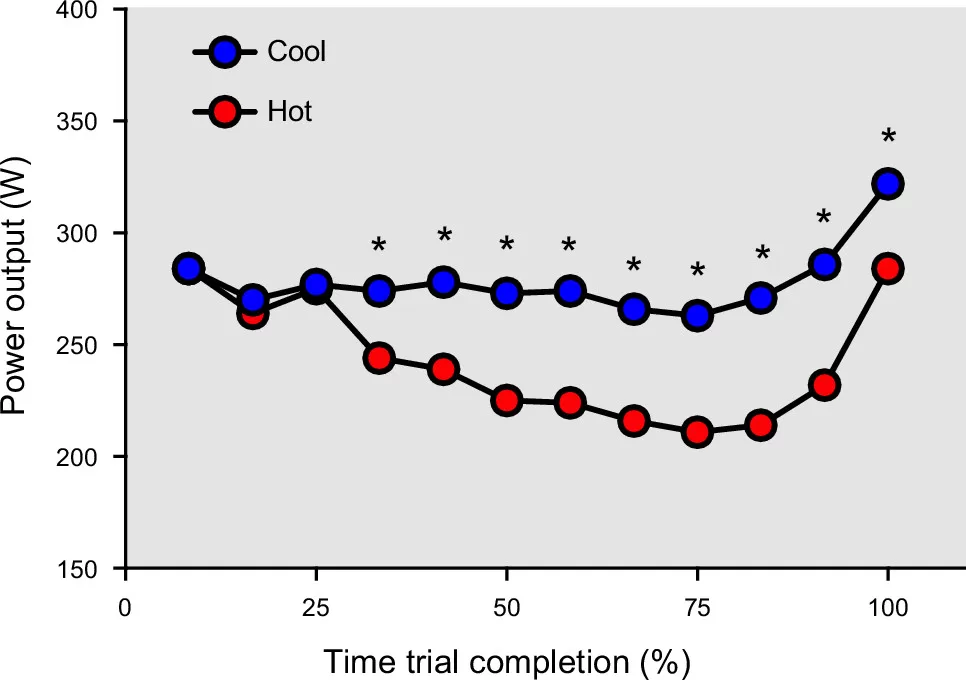
Figure and caption from: Periard et al. Physiological Reviews. 2021.
How much can heat stress impair your performance? The answer is a lot. In the data above, we can see that the power output by a cyclist performing a time trial is significantly reduced in hot vs cool conditions (~20% in the later time points). An important observation here is that there is no significant difference between power output for the first ~10 km of the time trial. The reason for this is that body core temperatures are similar up to this point. As core temperature rises, it reaches a point of hyperthermia where both VO2 max (the maximum oxygen your body can uptake) and FTP (your maximum sustained power output) decrease significantly. Decrease in VO2 max typically begins when body core temperature increase above 38 C (100.4 F) and gets progressively worse (~20% decrease at 39.5 C (~103 F)). Core temperatures above 40 C (104 F) are dangerous and associated with heat stroke. Hyperthermia is the biggest obstacle in terms of both performance and safety when cycling in the heat. In cool conditions, your muscles will typically fatigue before you can produce an excessive amount of heat.
I’ve discussed several strategies so far that will keep your riding cooler, but I haven’t discussed the impact of training yet. So, can you train your body to cool itself better? Fortunately, the answer is yes! Heat acclimation is the physiological changes that can occur when an athlete begins training in warmer conditions. Two important changes include a higher sweat rate and an increase in blood plasma volume. A higher sweat rate allows for potentially more evaporative cooling and increased plasma volume can provide a greater capacity to transfer heat from your core to the skin. These adaptations can lead to a higher exercise capacity in the heat relative to the unacclimated state.
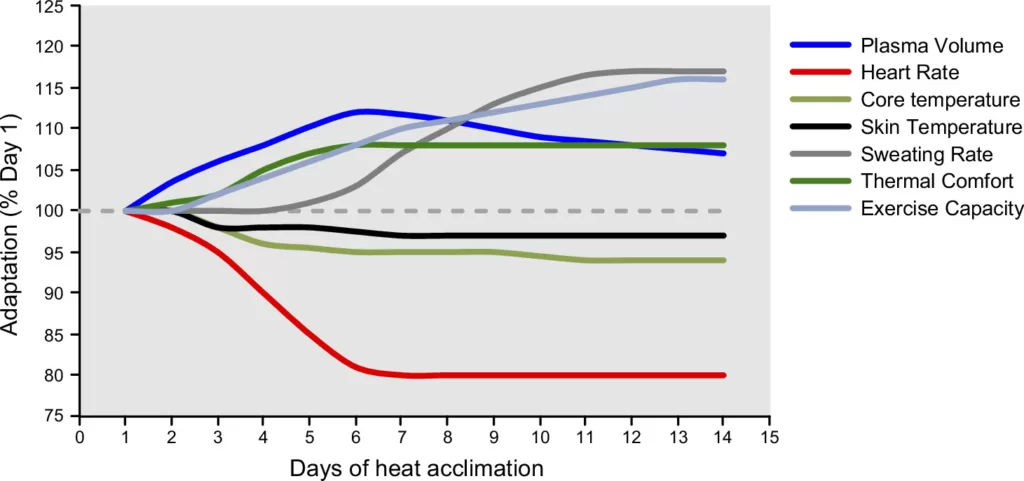
Figure and caption from: Periard et al. Physiological Reviews. 2021.
Individuals training for an event will probably want to follow a structured protocol. Many protocols exist, but to give you a general idea, one could ride in high heat (86F WGBT, ~96F Heat Index) at a low intensity for 60-90 minutes for at least 10 days. Heat acclimation decays with time so if the sessions are more spread out, it will take more sessions to reach maximum effect. If you don’t normally ride in the heat and are preparing for an event in the future, heat acclimation can be done well in advance as long as their are sufficient maintenance sessions in the intervening time. Here in central Texas, I don’t bother with a protocol since it’s so hot for so much of the year that I typically become heat acclimated before summer starts (yes, it is that hot here) and there’s little chance of significant decay before fall. If you live some place cooler and need to heat acclimate, there are alternative strategies including riding on a stationary trainer without a fan in a warm room or protocols that involve sauna sessions that you may want to investigate.
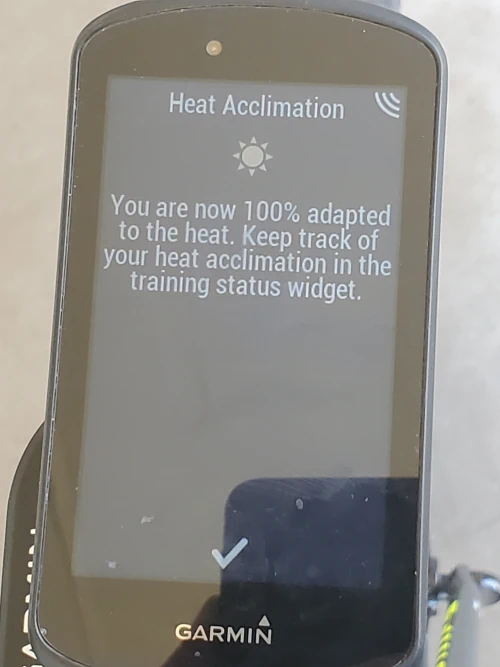
Some devices, including many Garmin devices, have functions that can provide feedback on heat acclimation status. For those with a compatible Garmin device, this information can be viewed on the device or at the Training Status page under Reports on the Garmin Connect site or through the Garmin Connect App at Training Status in the Performance Stats. I don’t have a lot of confidence in Garmin’s methods as they claim you can be heat adapted in as little as 4 days which isn’t consistent with published studies. I’m currently back in Austin, TX so the summers here are brutally hot and I get lots of heat exposure. I typically get heat acclimation feedback from my device in May/June and then it just stays at 100% until about October. For me, this isn’t really useful data.
How much of a benefit will you gain from heat acclimation? Well, there’s a lot of factors that can influence this. The biggest improvements will be in hot and dry conditions where increased sweat produced is likely to evaporate. One study showed that after two weeks of heat acclimation, time trial cyclists were able to reduce the power loss due to heat from ~16% to ~3% in hot and very dry conditions. In less favorable conditions (i.e. higher humidity) the improvements reported have been much less but are still significant. These studies focus on a specific type of road cycling (max sustainable outputs at high speeds for around an hour), and it’s not clear the extent to which those improvements translate across every type of riding. However, from the many studies on the topic (cycling as well as other sports) it is clear that heat acclimation does provide measurable benefits in the heat.
It’s important to remember that heat acclimation does not change the underlying issue that hyperthermia causes decreases in performance and can lead to heat related illness. To get the greatest benefits of heat acclimation you also need to ensure that you stay hydrated (to maintain enhanced plasma volume and support increased sweat rate) and maximize sweat evaporation (to benefit from the increased sweat rate).
6. Adequate Rest and Recovery
Cycling in the heat places increased stress on your body, and it’s easy to underestimate this if you’re focused on riding equivalent time, power, or miles compared to cooler weather. This type of issue could catch you as spring transitions to summer or during unanticipated heat waves. Not taking into account the additional strain from the heat can lead to over training and exhaustion. One common metric that will reveal the increased stress of cycling in the heat is heartrate. Heat stress results in an increased heart rate relative to effort (decoupling of heart rate from power). I always ride with heartrate monitoring (either from an optical sensor on a watch or an electrical sensor on a heart rate monitor chest strap), but I think this data is particularly useful in hot conditions because it provides immediate feedback on the increased strain. Perceived exertion can also guide you.
When you end your ride in the heat, you will continue sweating but will have lost the evaporative air flow and may find yourself suddenly soaked. Your core body temperature will remain elevated because of the decrease in evaporation so it can be beneficial to proactively take measures to lower your core temperature.
The fastest way to lower core body temperature is full immersion in circulating ice water. This is of course not practical, pleasant, or recommended and is generally reserved for heat illness emergencies. Typically, I go inside to have an ice cold drink to start topping up my hydration while standing in front of a fan to pre-cool before I go to the shower. It may seem odd that I don’t head immediately to a cool shower, but the reason is that a normal length shower will not drop my core temperature enough to stop sweating if I don’t pre-cool a bit. This is just a personal preference though to avoid becoming drenched with sweat afterwards. If you do find yourself sweating afterwards, drinking cold fluids and using a fan can help alleviate this. So what temperature shower would be best? A 15 minute shower in ~70F water will cool your core temperature from 102 F(39 C) to 100.4 F (38 C) (hence the need for pre-cooling if you want to avoid sweating afterwards). There is no significant benefit of taking a shower colder than this as studies have shown that it does not lead to faster cooling rate until you get to very cold temperatures near the freezing point.
It should be noted that none of the cooling methods that can be performed at home meet the minimum cooling rate suggested for heat stroke treatment. While attempts should be made to cool someone suffering from suspected heat stroke with whatever means are available, heat stroke is a medical emergency and requires prompt medical intervention.
7. Know When to Stop
There are temperatures and conditions in which cycling is simply unsafe and detrimental to fitness. Heed heat warnings and use good judgement. It’s possible that you will eventually find yourself in a situation where you did not expect extreme heat or were delayed and ended up in it unintentionally. You could also find that a place where you planned to refill on hydration is not available. Pushing on through the heat in these types of situations can be dangerous. Sometimes the best option is calling it a day and getting out of the heat.
Notice: Outdoor activities such as those described on this site are inherently dangerous. Effort has been put forth to present factual information but no guarantee is made that it is complete or represents current conditions. You assume all risk with any use of the information on this site.
